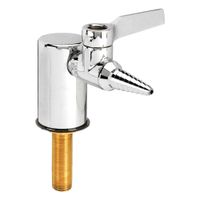Call +(254) 703 030 000 / 751 483 999 / 721 704 777
- Home
- Lab Supplies
- Lab Furniture Accessories
.....Read More
Frequently Asked Questions
What are the essential types of lab furniture needed for a laboratory?
Essential laboratory furniture includes workbenches and lab tables, which are crucial for conducting experiments and housing equipment. Storage solutions like cabinets and shelving are necessary for organizing chemicals, samples, and apparatus, ensuring safety and accessibility. Fume hoods are vital for ventilating hazardous fumes, protecting personnel from exposure. Seating, such as lab chairs or stools, should be ergonomic and resistant to spills. Specialty furniture like desiccators, incubators, or biosafety cabinets may also be required depending on the lab's specific functions. All lab furniture should be durable, easy to clean, and resistant to chemicals to maintain a safe and efficient working environment.
How do I choose the right lab table material for my experiments?
Choosing the right lab table material is crucial for the safety and success of experiments. Several factors should be considered.
First, assess the types of chemicals and reagents you'll be using. If strong acids, bases, or solvents are common, opt for materials with high chemical resistance like epoxy resin, phenolic resin, or stainless steel. These materials are non-porous and can withstand spills without degradation.
Second, consider the physical demands. If heavy equipment or high-impact activities are involved, a durable material like stainless steel or a solid epoxy worktop is beneficial. For heat-intensive experiments, fire-resistant options are necessary.
Third, hygiene and ease of cleaning are important, especially in biological or sterile environments. Non-porous surfaces like stainless steel, epoxy resin, and phenolic resin are easy to decontaminate and resist bacterial growth.
Fourth, budget constraints should also be taken into account. While stainless steel and epoxy resin offer excellent performance, they can be more expensive. Less costly alternatives like laminate might suffice for labs with less demanding requirements.
Finally, think about the specific experimental needs. For example, some experiments might require anti-static surfaces, while others might benefit from materials that can be easily repaired or modified. Evaluating these factors will help you select a lab table material that ensures safety, longevity, and experimental integrity.
What are the benefits of height-adjustable lab chairs and stools?
Height-adjustable lab chairs and stools offer numerous benefits that enhance comfort, productivity, and safety in laboratory environments. A primary advantage is improved ergonomics. Users can easily adjust the seat height, backrest, and sometimes armrests to achieve a neutral posture, reducing strain on the back, neck, and shoulders. This adaptability accommodates individuals of varying heights and body types, promoting better circulation and minimizing the risk of musculoskeletal disorders from prolonged sitting.
Another key benefit is versatility. Height-adjustable seating can be used with different lab equipment and workstations, whether it's a standard desk, a fume hood, or a microscope station. This flexibility allows users to maintain optimal working distances and angles, leading to increased precision and efficiency in tasks.
Furthermore, these chairs and stools promote dynamic sitting. The ability to frequently adjust height encourages subtle movements, which can prevent stiffness and fatigue associated with static postures. Some models also offer tilt and swivel functions, further enhancing mobility and comfort.
Finally, they contribute to a safer lab environment. By allowing users to position themselves correctly relative to their work, height-adjustable seating can reduce the likelihood of accidents due to awkward reaching or poor visibility. Their robust construction and specialized materials (e.g., easy-to-clean, chemical-resistant fabrics) also ensure durability and hygiene, making them ideal for demanding lab conditions.
How can lab cabinets and shelving help organize a laboratory?
Lab cabinets and shelving are essential for maintaining an organized and efficient laboratory environment. They provide designated storage spaces for reagents, samples, equipment, and glassware, which helps in preventing clutter and ensuring easy access to necessary items. Proper organization reduces the risk of accidents by keeping hazardous materials securely stored and separated.
Cabinets often come with adjustable shelves, allowing for customization based on the size and type of items being stored. This flexibility maximizes storage capacity and improves workflow. Shelving units, whether open or closed, allow for categorization and labeling of materials, making inventory management simpler and quicker. For instance, frequently used items can be placed on open shelves for easy retrieval, while sensitive or valuable materials can be stored in locked cabinets for security.
Furthermore, specialized cabinets, such as those designed for flammable liquids or corrosive chemicals, ensure compliance with safety regulations and minimize exposure risks. By systematically organizing a lab with appropriate storage solutions, laboratories can improve productivity, reduce search times for materials, and maintain a safer working environment.
What factors should be considered when selecting lab gas fittings and valves?
When selecting lab gas fittings and valves, several critical factors should be considered to ensure safety, efficiency, and system integrity. First, the type of gas being used is paramount. Different gases have varying chemical properties, pressures, and purity requirements, necessitating compatible materials for fittings and valves to prevent corrosion, leaks, or contamination. For example, inert gases like nitrogen or argon might allow for brass fittings, while corrosive gases like chlorine or hydrogen sulfide would require stainless steel or specialized alloys.
Second, the operating pressure and temperature are crucial. Fittings and valves must be rated to safely handle the maximum anticipated pressure and temperature fluctuations of the gas system. Exceeding these ratings can lead to catastrophic failures.
Third, material compatibility extends beyond just chemical resistance to include concerns about outgassing and particulate generation, especially in high-purity or ultra-high-purity applications. For such demanding environments, electropolished stainless steel and specialized sealing materials like PTFE or PCTFE are often preferred to minimize contamination.
Fourth, the connection type (e.g., NPT, Swagelok, VCR) is important for ensuring proper sealing and ease of installation and maintenance. Standardized connections help prevent mismatches and leaks.
Fifth, the flow control requirements dictate the type of valve needed. Options include ball valves for quick on/off control, needle valves for precise flow regulation, and diaphragm valves for high-purity applications where stem packing contamination is a concern.
Finally, safety features such as pressure relief valves, excess flow valves, and backflow preventers are essential to mitigate risks associated with overpressure, line breaks, and contamination. Regular maintenance and proper installation also play a vital role in the long-term reliability and safety of lab gas systems.
How do raceways and supports enhance laboratory functionality?
Raceways and supports are critical for enhancing laboratory functionality by providing organized, secure, and flexible infrastructure for cabling, piping, and equipment. They ensure that electrical wiring, data cables, and fluid lines are neatly routed, protected from damage, and easily accessible for maintenance or modifications. This organization prevents clutter, reduces trip hazards, and minimizes electromagnetic interference, which is crucial for sensitive laboratory equipment.
Furthermore, these systems allow for efficient airflow and cooling, preventing equipment overheating and ensuring optimal performance. In a dynamic laboratory environment, raceways and supports facilitate quick reconfigurations and expansions without extensive downtime, as new connections can be added or existing ones modified with ease. This adaptability is vital for laboratories that frequently change their setups to accommodate new experiments or technologies.
Ultimately, by contributing to a safer, more efficient, and adaptable workspace, raceways and supports improve productivity, extend the lifespan of valuable equipment, and ensure the reliability of experimental results.
What are the safety features of lab shields?
Lab shields are essential safety equipment designed to protect users from various hazards in a laboratory setting. Their safety features primarily focus on providing robust barriers against chemical splashes, flying debris, heat, and radiation.
One of the most critical features is the material composition, often made from shatter-resistant and chemical-resistant plastics like polycarbonate or acrylic. These materials are chosen for their ability to withstand impact and prevent corrosive substances from degrading the shield's integrity. Some advanced shields may also incorporate specialized glass for enhanced optical clarity and scratch resistance.
Another key safety feature is their stable and often adjustable base, which prevents accidental tipping and ensures the shield remains securely in place during experiments. Many shields are designed with an ergonomic tilt, allowing users to position the barrier optimally for both protection and visibility.
Ventilation is also a consideration in some lab shield designs, particularly for procedures involving fumes. While not all shields offer active ventilation, their design can help direct airflow away from the user. For applications involving high heat or open flames, fire-resistant materials are used to prevent the shield from igniting or melting.
Overall, the combination of sturdy, resistant materials, stable designs, and thoughtful ergonomic considerations makes lab shields an indispensable tool for maintaining a safe working environment in laboratories.
How can I maximize space in a small laboratory with lab furniture?
To maximize space in a small laboratory with lab furniture, consider multi-functional and modular pieces. Vertical storage solutions like tall cabinets and shelving units can significantly increase storage without occupying valuable floor space. Wall-mounted desks or fold-down workstations can be deployed when needed and stored away when not in use. Mobile carts or benches with wheels offer flexibility, allowing for easy rearrangement and adaptation to different tasks. Integrated solutions, such as benchtops with built-in sinks or power outlets, can reduce clutter and streamline workflows. Custom-built furniture designed to fit specific dimensions and corners can also make the most of every available inch. Additionally, selecting compact equipment and organizing supplies efficiently can further optimize the limited space.
What are the maintenance requirements for different types of lab furniture?
Regular cleaning with appropriate disinfectants is essential for all lab furniture to prevent contamination and maintain a sterile environment. The specific cleaning agents and methods will vary depending on the material of the furniture. For example, stainless steel surfaces should be cleaned with non-abrasive cleaners to avoid scratching, while wooden furniture may require specific wood-safe cleaners and occasional polishing.
Fume hoods require regular inspection and calibration of their airflow to ensure proper ventilation and personnel safety. Filters in fume hoods should be replaced according to manufacturer recommendations.
Lab casework, including cabinets and benchtops, should be checked for any signs of wear, cracks, or damage, which could compromise their integrity or allow for chemical leaks. Spills should be cleaned immediately to prevent etching or staining.
Seating, such as lab chairs and stools, should be inspected for stability and proper functioning of adjustable components. Upholstery should be kept clean and free from tears.
Electrical equipment, such as power outlets integrated into benchtops, should be regularly checked for frayed wires or loose connections to prevent electrical hazards.
Ultimately, adherence to manufacturer guidelines and a proactive maintenance schedule are crucial for extending the lifespan of lab furniture and ensuring a safe and efficient laboratory environment.
How do I ensure compliance with safety standards when setting up a lab?
Ensuring compliance with safety standards when setting up a lab involves several key steps. First, a thorough risk assessment should be conducted to identify potential hazards, including chemical, biological, physical, and ergonomic risks. This assessment will inform the design of the lab and the implementation of appropriate controls.
Second, the lab design must adhere to relevant local, national, and international safety regulations and standards (e.g., OSHA, CLSI, ISO). This includes proper ventilation systems (fume hoods, biological safety cabinets), emergency exits, fire suppression systems, and designated areas for hazardous waste disposal. Eyewash stations and safety showers should be readily accessible.
Third, develop comprehensive safety protocols and standard operating procedures (SOPs) for all lab activities, including handling chemicals, biological materials, and equipment. These SOPs should cover emergency procedures, spill response, and personal protective equipment (PPE) requirements.
Fourth, provide mandatory safety training to all lab personnel covering general lab safety, hazard-specific training, and proper use of equipment and PPE. Regular refresher training is crucial.
Fifth, establish a robust waste management program for all types of lab waste, ensuring proper segregation, labeling, storage, and disposal in accordance with regulations.
Finally, implement a system for regular safety audits and inspections to identify and address any non-compliance issues. Maintain detailed records of all safety training, incidents, and corrective actions. A strong safety culture, where all personnel are actively engaged in maintaining a safe environment, is paramount.








